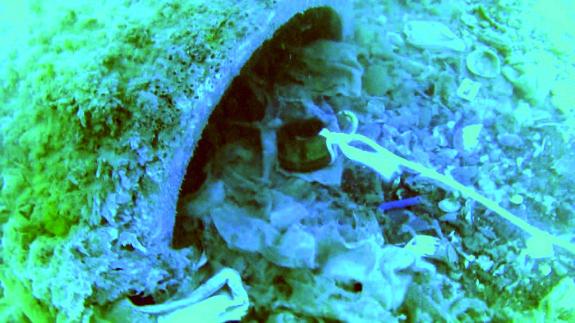

Secciones
Servicios
Destacamos

JUAN CANO / ÁLVARO FRÍAS
Friday, 22 March 2019, 10:18
Imagine, if you can, a seabed where instead of thriving seagrass there is a carpet of wet wipes. One already exists on the Costa del Sol, just 700 metres from the Maro-Cerro Gordo nature reserve, near Nerja. Guardia Civil investigators and scientists witnessed it in a five-day study last summer as part of their Operation Vastum inquiries.
Based on photos and videos taken off the Nerja coastline at a depth of up to about 50 metres, they say that the bottom of the Mediterranean is home to a build-up of nine tonnes of the small disposable towels.
So far 16 former and current public officials in Nerja and Coín have been questioned as part of the investigation into "serious irregularities" in the dumping of untreated sewage in waterways and out at sea.
In Nerja, three outflow pipes pump effluent into the sea. One is only in water two metres deep and close to a protected natural area; it can be seen from any boat or kayak. The others, offshore from Burriana and Torrecilla beach, end about a kilometre out and the raw sewage flows in at a depth of about 40-50 metres.
As part of their study last August, Seprona, the specialist environmental agency of the Guardia Civil, used professional divers and sounding teams to assess the extent of the affected area. They called on the government's Instituto Español de Oceanografía, the national ocean-study institute, and used its 46-metre-long survey ship, the Ángeles Alvariño, which is normally based in Galicia.
The cost for the expedition was 11,000 euros, which is paid for by the government but can potentially be recovered if anyone is eventually tried and found guilty.
Public prosecutor
The public prosecutor with responsibility for environmental cases in Malaga, Fernando Benítez, was on deck to witness the extent of the wet wipe "mountain" first hand via the video link.
He described the situation as "very worrying", as "the marine life is being upset by public authorities' inefficiency."
As well as identifying the destruction of an important area of protected shellfish, investigators saw that new species were appearing and taking advantage of the polluted water.
They reported back on a sort "crust" that forms over the residue from the pipe, hugging its opening, and a layer of waste 20 metres in diameter and, in some places, three metres deep, full of plastic and other solid waste, but mostly wet wipes.
Publicidad
Publicidad
Publicidad
Publicidad
Esta funcionalidad es exclusiva para registrados.
Reporta un error en esta noticia

Debido a un error no hemos podido dar de alta tu suscripción.
Por favor, ponte en contacto con Atención al Cliente.

¡Bienvenido a SURINENGLISH!

Tu suscripción con Google se ha realizado correctamente, pero ya tenías otra suscripción activa en SURINENGLISH.
Déjanos tus datos y nos pondremos en contacto contigo para analizar tu caso

¡Tu suscripción con Google se ha realizado correctamente!
La compra se ha asociado al siguiente email
Comentar es una ventaja exclusiva para registrados
¿Ya eres registrado?
Inicia sesiónNecesitas ser suscriptor para poder votar.